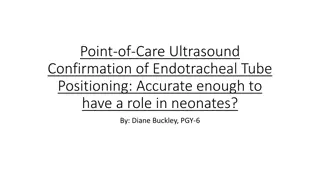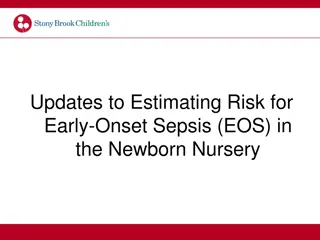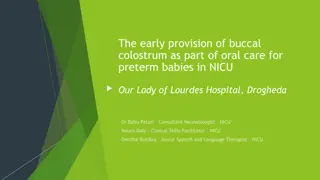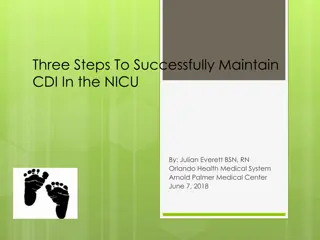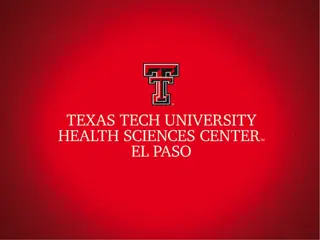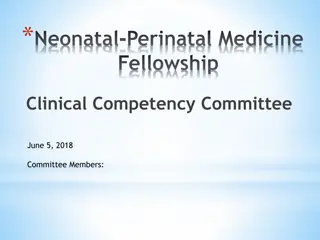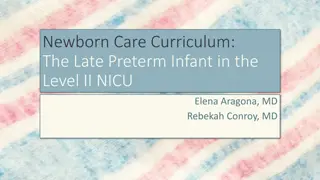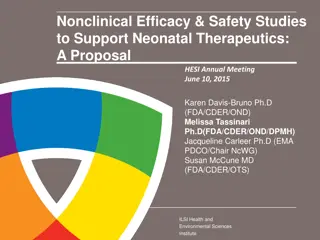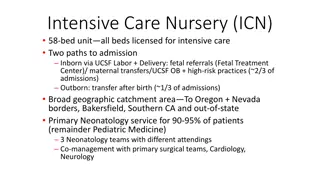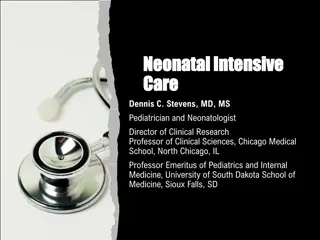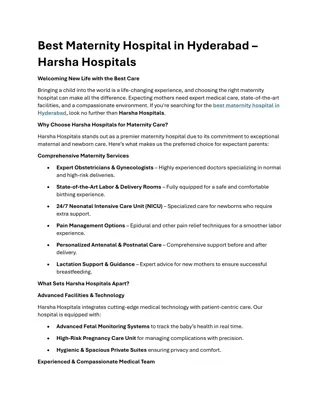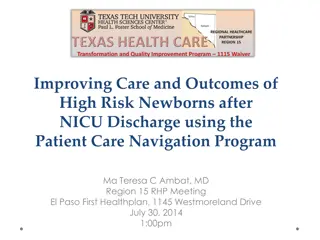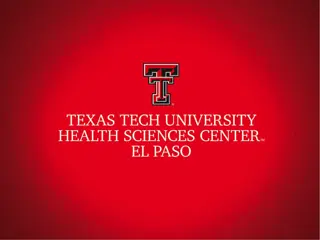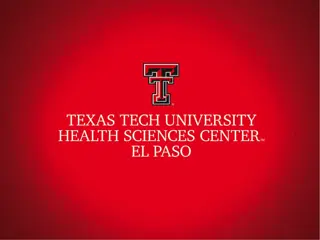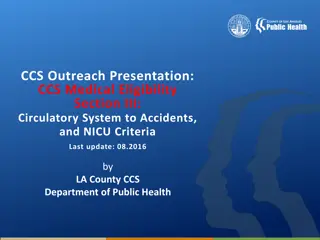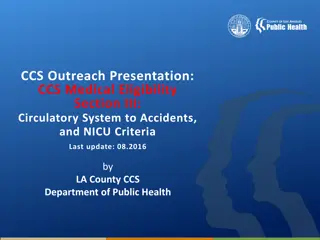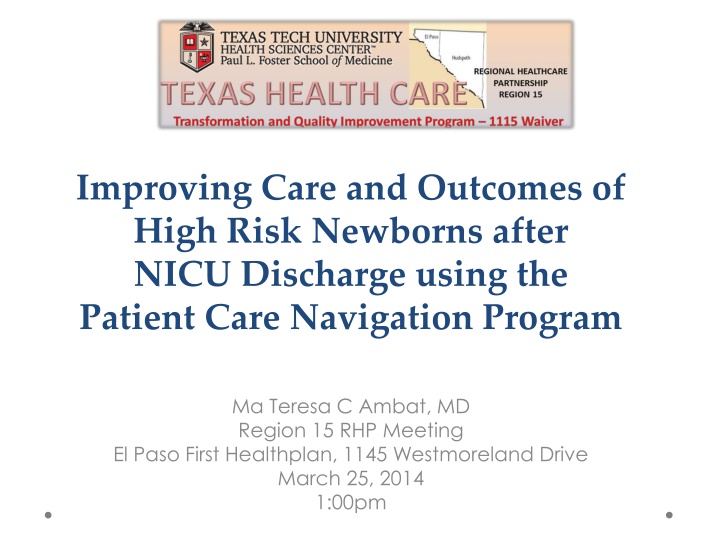
Enhancing Care for High-Risk Newborns Post-NICU Discharge
Learn about the Patient Care Navigation Program focusing on high-risk newborns after NICU discharge at Texas Tech University Health Sciences Center. Explore project milestones, metrics, and navigation services provided to enrolled patients to improve outcomes.
Uploaded on | 3 Views
Download Presentation

Please find below an Image/Link to download the presentation.
The content on the website is provided AS IS for your information and personal use only. It may not be sold, licensed, or shared on other websites without obtaining consent from the author. If you encounter any issues during the download, it is possible that the publisher has removed the file from their server.
You are allowed to download the files provided on this website for personal or commercial use, subject to the condition that they are used lawfully. All files are the property of their respective owners.
The content on the website is provided AS IS for your information and personal use only. It may not be sold, licensed, or shared on other websites without obtaining consent from the author.
E N D
Presentation Transcript
Improving Care and Outcomes of High Risk Newborns after NICU Discharge using the Patient Care Navigation Program Ma Teresa C Ambat, MD Region 15 RHP Meeting El Paso First Healthplan, 1145 Westmoreland Drive March 25, 2014 1:00pm
Description of the Project o Patient Care Navigation Program within the High Risk Clinic, a neonatal follow-up program at Texas Tech University Health Sciences Center (TTUHSC) El Paso - Department of Pediatrics o Target infants born at < 32 weeks gestational age and/or infants whose birth weight was < 1500 grams a cohort of high-risk patients discharged from the El Paso Children s Hospital (EPCH) Neonatal Intensive Care Unit (NICU)
Project Milestones and Metrics P2.1: Number of People Trained as Patient Navigators Goal: 1 Additional Patient Navigator hired and trained DY 3: Met milestone, 1 person hired start date 8/20/2014 DY 4 & 5: Excluded from milestones P2.2: Develop Outreach Plan to enroll patients in Navigation Program Goal: Complete Patient Outreach Plan DY 3: Completed and submitted 8/7/14 DY 4 & 5: Excluded from milestones
Project Milestones and Metrics P-10.1: (Customized) Report on types of services provided to high risk patients enrolled in the program Goal: Complete report on those services provided to High Risk Patients DY 3 Navigators use EMR form to document the services (started in 6/2014). Total services from June Sept 2014: 326 Top 5 services: Care Coordination High Risk Clinic, Care Coordination PCP, System navigation DME issues, Apnea monitoring, Phone calls prior to High Risk clinic visit
Navigation Services DY 4 Oct Nov Dec Jan Feb Mar Total Total Services 292 160 202 230 288 85 1257 Top 5 services Care Coordination High Risk Clinic 80 51 77 73 99 27 407 Phone calls - Each High Risk Clinic visit 44 20 17 25 38 10 154 Education - appropriate use of services 14 6 16 8 21 9 74 Care Coordination - PCP 25 9 16 8 14 1 72 Care Coordination - other issues 7 3 4 14 23 6 57 Other services: Care Coordination PCP, System navigation DME issues, Apnea monitoring, care coordination for subspecialty ff-up, barriers to access, insurance services, phone calls 2 weeks after NICU discharge, prescriptions, social services, home health, referrals to ECI and other rehab facility, triage medical problems, etc.
Project Milestones and Metrics P-8.1: Participate in semi annual face-to-face meetings or seminars organized by the RHP Goal: Participate in at least 2 face-to-face meetings/seminars 1stmeeting: 7/30/2014 2ndmeeting: 9/24/2014 DY 3 1stmeeting: 3/25/2015 2ndmeeting: TBD DY 4 I-10.2: Increase Number of Unique Patients served by Navigator Program Goal: 30 50 Patient enrolled Oct 2013 - Sept 2014: 54 (out of 74 patients recruited = 73%) DY 3 DY 4 Goal: 55 Patient enrolled Oct 2014 March 23, 2015: 32 (out of 38 patients recruited = 84 %)
Category 3 Measures IT 8.21. Developmental screening in the first 3 years of life. Indicator: The percentage of children who had screening for risk of developmental, behavioral and social delays using a standardized screening tool documented by 12 months of age. Denominator: Target patients who turn 12 months of age between Jan Dec of measurement year. Targeted patients: Premature infants enrolled in the program (< 32 weeks and or birth weight < 1500grams). Communication and Symbolic Behavior Scales Developmental Profile (CSBS-DP) performed during high risk clinic visit on target patients starting at 9 months chronologic age (started in June 2014). DY 3 DY 4 Total number of targeted patients who turned 12 months of measurement year 13 17 Total number of targeted patients who received developmental screening using CSBS-DP 52 57 Total number of targeted patients who received developmental screening using CSBS-DP (%) 25% Goal 26.25% As of Feb 2015: 30%
Category 3 Measures IT 9.9. Transition record with specified elements received by discharged patients. Measure: Percentage of patients who received transition record at the time of discharge. Targeted condition Premature infants < 34 weeks admitted and discharged at El Paso Children s Hospital NICU must have documentation of receipt of transition record. Transition record entered as an event by residents/NNPs at discharge (started in June 2014). Tracking done monthly. DY 3 DY 4 Total patients Discharged < 34 weeks GA 99 32 Patients transition record with documented receipt of 31 26 Patients transition record (%) with documented receipt of 31.3% Goal: 32.8% As of Feb 2015: 81%
Category 3 Measures IT 8.25. Sudden Infant Death Syndrome Counseling Measure: Percentage of children 6 months of age who had documented Sudden Infant Death Syndrome (SIDS) counseling. Numerator: Children who had documented SIDS counseling within 4 weeks of birth or by first pediatric visit, whichever comes first. Denominator: Children who turned 6 months of age during the measurement year. Targeted facility. All infants discharged from the El Paso Children s Hospital NICU. SIDS counseling incorporated in discharge teaching on all infants discharged from the El Paso Children s Hospital NICU. SIDS counseling is entered as an event in Site of Care by residents/NNPs for documentation (tracking started in June). DY 3 DY 4 Children discharged from EPCH NICU who turned 6 months of age during the measurement year 514 918 Number of patients who received SIDS counseling 0 664 Number of patients who received SIDS counseling (%) Baseline of 0% None of those patients who received SIDS counseling from June Sept 2014 had turned 6 months. Goal: 5% As of Feb 2015: 72%
P4R Measure attached to IT 8.25. Tracking of deliveries at UMC with BW <2500g Year/Month Number of deliveries BW <2500 g Total deliveries (live births) at UMC % 2014 October 10 338 November 4 296 December 21 332 2015 January 18 309 February 5 260 Total as of Feb 2015 58 1535 3.8%
Quality Improvement (PDSA) Goals o Promoting compliance with ff-up appointment at High Risk Clinic Neonatal Follow-up program o Increase retention of patients enrolled in the program until discharge o Improve services o Increase parent satisfaction
Quality Improvement (PDSA) 1. Phone call reminders to parents of SCC appointment Changed the day and time of phone call reminder to parent (Wednesday PM, Thursday AM) Early notification allowed for early identification of problems/barriers to keeping appointment and address problems in time which allowed parents to make any arrangements needed (examples: transportation arrangement for appointment, child care arrangements for siblings) 2. Family meetings prior to hospital discharge First meeting scheduled 1 week prior to discharge, ff-up meeting 1-2 days prior to discharge 3. Hospital discharge welcome packet to SCC services Parents are provided welcome packet prior to hospital discharge which contains information on Texas Tech pediatric services, phone numbers of the High Risk Clinic, community agencies, growth and development baby booklet Strategies 2 and 3 allowed for better understanding of High Risk Clinic services, established rapport between families and clinic and reinforced the role of navigators/coordinators as advocate and liaison to assist families in successful transition from NICU to home
Quality Improvement (PDSA) 4. Texas Tech Welcome to first High Risk Clinic Visit On the first High Risk Clinic visit, navigators review with families information on clinic visit processes and care navigation services Reiterated importance of high risk clinic visits and its impact on long-term outcomes to encourage compliance and parents participation in the care of their infants Provided continued reassurance to families that they have partners who can help them be successful in taking care of their babies 5. Follow up appointment scheduled prior to leaving exam room Reduced time in the clinic and promote satisfaction Prevented missed appointment by having the follow-up appointment scheduled prior to leaving the exam room 6. Scheduling High Risk Clinic visits at 1 hour intervals Reduced waiting time, cancellation and rescheduling of appointment Reduced pressure placed on practitioner to readily see patient Spacing all SCC visits to 1 hour intervals allowed practitioner to have longer face-to-face encounter with patients
Upcoming Projects Preemie Baby s Day Out May 7, 2015, 2-5PM at Texas Tech o Provide opportunities for gathering of families to connect with one another for support as they share their stories and a time to honor them o Educational presentations on interventions, appropriate use resources to assist families as they increase their ability and confidence to care for their infants after NICU discharge developmental of services care community and and
QUESTIONS? COMMENTS?


